1. Timeline
- 1931 Great Depression hits France.
- 1932 Washington Conference
- 1934 Stavisky Affair, right-wing coup
- 1935 Reaction to the Saar
- 1935 Hoare-Laval Pact
- 1936 Popular Front election victory, Leon Blum, Stresa Front, Reaction to the reoccupation of the Rhineland, Reaction to the Spanish Civil War, Appeasement, Matignon Agreements, Gold Standard abandoned.
- 1939 France goes to war against Germany. The government outlaws the Communist Party.
- 1940 Germany successfully invaded France, bypassing the Maginot Line.
- 1940 Northern France became Nazi-occupied but the southern half became Vichy France.
2. Foreign Policies
- The French government strived to develop or maintain alliances with Eastern European countries, in the hope of deterring a future German invasion.
- France was neutral for much of the decade, preferring to stay out of the Spanish Civil War (Non-intervention Pact, 1937), acquiescing towards Italy with the Hoare-Laval Pact (in the hope Mussolini would not strengthen his relationship with Hitler – although he did in 1936 with the Rome-Berlin Axis) and accepting the German reacquisition of the Rhineland in 1936 (Britain refused to use force too and France could not do so alone).
- In 1928, France decided to build the Maginot Line, a defensive structure from Switzerland to the North Sea. However, Belgium refused to cooperate because of its perception of French weakness and desire not to antagonise Germany in the future, so the Line was only strong up to the French/ Belgian border. Furthermore, Mussolini also saw this weakness and opted to side with Hitler rather than France, even though he had reservations over Germany’s relationship with Italy’s rival, Austria.
- The joint British/French policy of appeasement was implemented from 1936 to 1939. It culminated in the Munich Conference of 1938, whereby the Sudetenland was ceded to Germany from Czechoslovakia. It was hoped this would prevent war although Hitler went back on his promise to leave Germany alone in March 1939, ending the appeasement policy.
How Britain and France saw Appeasement
- It is important to know that the French military was one of the strongest in the world in the 1930s. In addition to the construction of the Maginot Line, the country spent a huge amount of money on its armed forces. Arguably, this was because it feared the resurgence of Germany. The table below is evidence of France outspent her rivals in the 1930s.
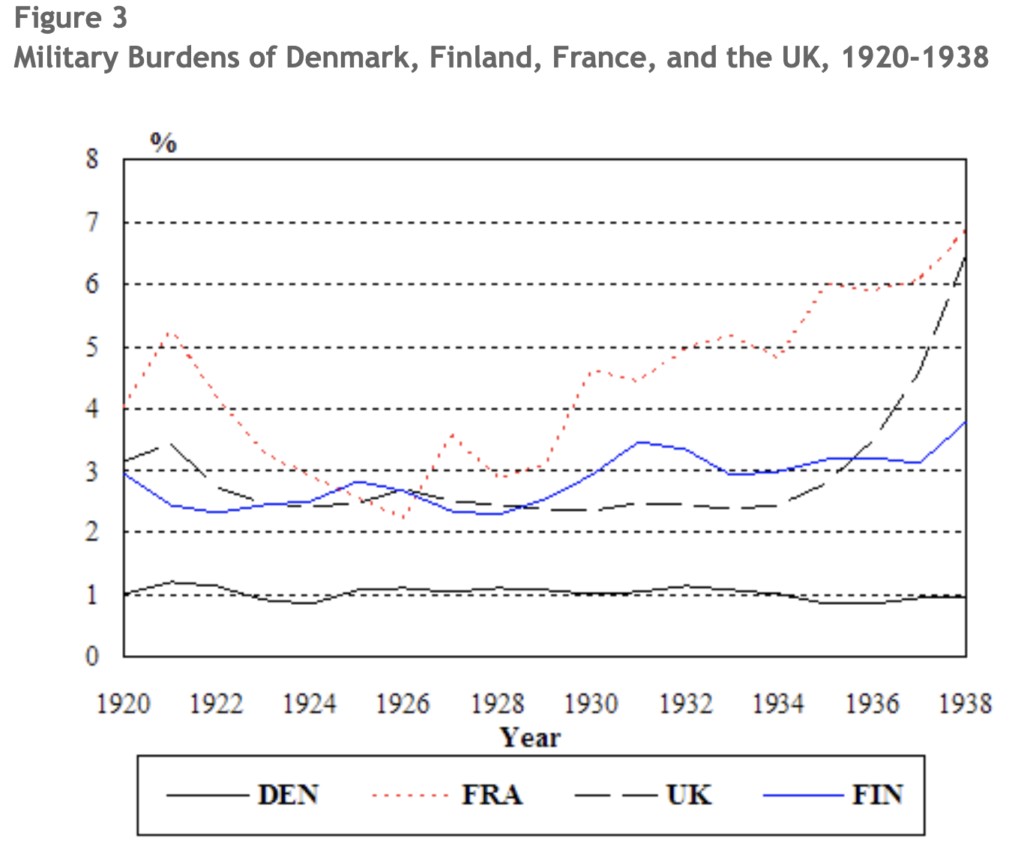
- This view is supported by Martin Thomas in ‘At the Heart of Things? French Imperial Defense Planning in the Late 1930s‘.

- He adds that the French could count on hundreds of thousands of colonial troops (Tunisia, Algeria and Morocco) as well, as they had done so in the Great War.
3. Social and Economic Issues
- The Great Depression did not hit France until 1931. Exports declined and this affected both the industrial production of the country and food prices. This greatly affected the political issues facing France, western governments struggled to find solutions to the global crisis through diplomatic means.
- In the first half of 1931, there were 40 000 unemployed each month – remember that there was full employment in the 1920s. Although the figure for France was lower than many others, it did not take into account one million immigrants who returned home or who moved back to the countryside.
- Agriculture suffered hugely because of oversupply, prices dropped significantly as a result and consequently, incomes for farmers did too.
- The Depression in France lasted longer than in other countries, the political instability one of the reasons why. Moreover, the decision to maintain the franc on the gold standard (not leaving it until 1936) did not allow the government to devalue in order to increase exports (this was maintained to control inflation, a huge concern of the 1920s).
- France’s share of international trade plummeted by 44% by 1935, the government attempted to increase their exports to colonies but this did not make up for the shortfall.
- The Popular Front’s victory in 1936 introduced the Matignon Agreements (after two million workers went on strike demanding the new government enact more extreme policies). These were designed to stop the national strikes and to reform the economy. They included a wage increase of 10%, a forty-hour working week and annual holidays for workers and for industry, armaments, rail and the Bank of France were put under government control. These policies (agreed by employers) were initially popular but gradually led to a worsening economy – companies raised prices to accommodate the increased wages and productivity fell because of the reduced working week.
4. Political Issues
- As with other countries, governments found it difficult to deal with the economic problems caused by the Depression so France was politically unstable. It faced problems from the Right (the 1930s saw the growth of the right and Fascism. The Action Francaise, Croix de Feu (former soldiers) and Jeunesse Patriotes were a constant threat to the stability of the government especially as they saw the success of Mussolini, Franco and Hitler.
- The Stavisky Affair led to further criticisms of the government for corruption and anti-Semitism. It was enough to bring the government down and led to Edouard Daladier (Radical Party) becoming the leader.
- But in 1934, there was a right-wing coup which used the Stavisky Affair as evidence that parliamentary democracy and the government were failing. It failed with huge demonstrations from the Left and the moderates supporting the Republic, and the police killing seventeen in the riots which also took place.
- Who supported the Right? As in other European nations, these nationalist groups were funded by wealthy donors. The middle class also supported them (because their savings suffered due to inflation), preferring their ideologies than the socialists or even the Republic itself. People who opposed the Bolsheviks tended to support the Right and those who were anti-Semitic or xenophobic. As many immigrants came into the country too (from Italy and Spain – escaping their right-wing authoritarian regimes, Poland and many Jews, mainly from Russia who had escaped the Russian Civil War and the rule of the Bolsheviks) France faced a political backlash from the right.
- With regards to Italy and Spain, among the immigrants were ‘progressives’ on the left. This would only further antagonise French nationalists.
- In 1935, the Left responded to the increasing support for the Right with the formation of the Popular Front, with the Communists, Socialists, and Radicals all under one umbrella. The Left had been frightened by the coup and decided they had to act. It was elected in 1936 and introduced sweeping social reforms.
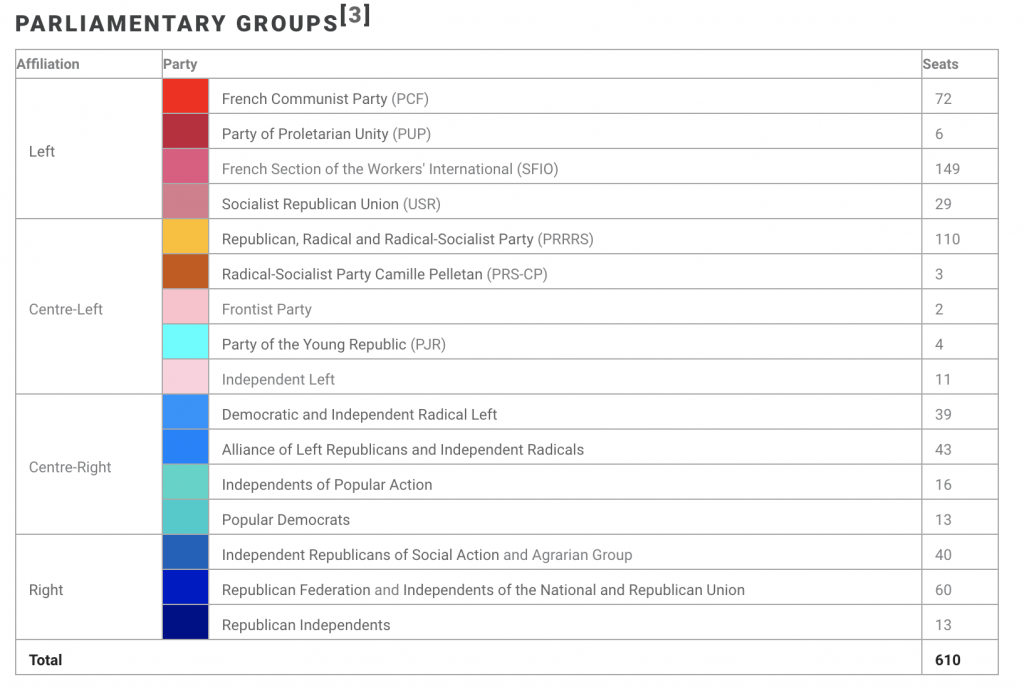
- However, it could not solve the economic problems as it promised to and had several prime ministers between 1936 and 1940.
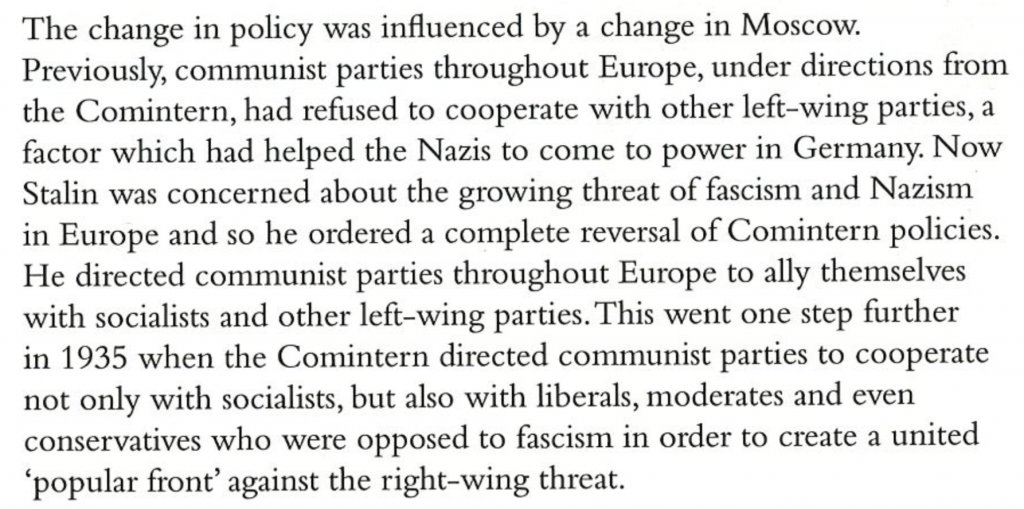
- As evidence of political instability, they had eight different governments between 1932 and 1934. They tried to reduce public spending and raise taxes but this did not help solve the problems of the country. For example, by reducing public spending it decreased demand so prices became lower – profits affected – unemployment and/or wages reduced.
- In response to the 1936 general strike, where two million workers occupied factories, the Matignon Agreements were passed. They were welcomed by the working class and lower-middle-class but not so for business leaders and the right. Inflation was caused by the wage increased and production fell because of the reduced working week.
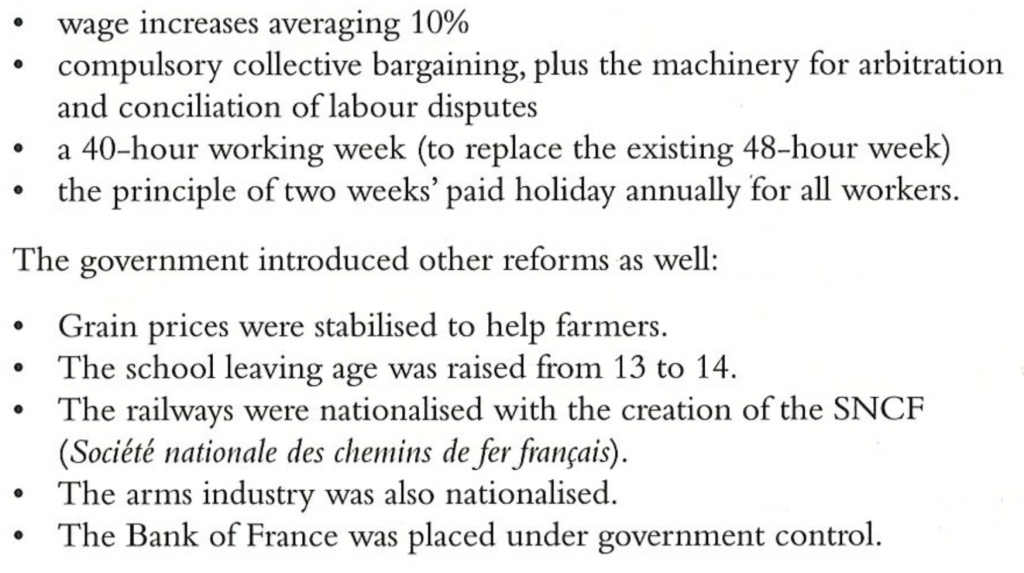
- As a result of fascists gaining power in Europe, Stalin and Comintern directed communists to ally with other socialists and left-supporting parties (see a response in the image below). In France, this led to the formation of the Popular Front. The parties were unified in stopping the right and had campaigned on policies such as a shorter working day, government controls for prices, more benefits to workers, more support for the League of Nations and disarmament, and changing the tax system, but had differences in how they were to govern. However, when Leon Blum achieved power, the communists refused to work with him as part of the government but he also refused to work with them.
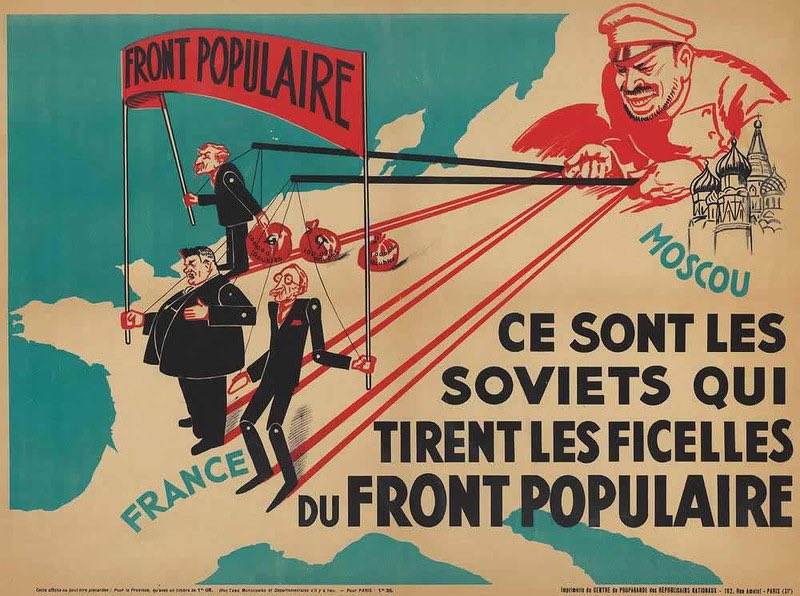
French Popular Front Gov’t, 1936-38, top to bottom: Socialist Minister of Air Marcel Déat, Communist leader Maurice Thorez, and Socialist Prime Minister André Léon Blum.
- One of the problems for Blum was that he was Jewish – therefore difficult for the Right to support him, and he was bourgeois – so the Communists may not support him either. As they had 330 000 members by 1936, they had considerable influence politically in France and particularly in Paris.
- This worsened when Blum refused to offer Republicans in the Spanish Civil War any aid. He wanted to act but the Radicals in his coalition and the British government persuaded him not to. In doing so, he lost support from socialists and communists, and the eventual breakup of the Popular Front.
- Blum resigned in 1937 as he opted to strengthen the economy at the expense of social reform. He tried to appease French businesspeople and prevent capital flight. As a result, he lost the support of the Left in the Popular Front. When he sought to rule by decree, an authoritarian measure, the growing number of opponents refused and he was asked to step down. Even though returning in 1938, the Popular Front was weakened.
- The weaknesses and instability in the country may have led to the defeat of France during the Second World War. It was invaded in June 1940 and its much-praised pre-war armed forces were easily defeated. Had the country been more unified, especially over the economy, things may have gone differently.
Note: France was similar to Spain in its political problems during the 1930s. It could have led to civil war but there are important differences that kept the country ‘peaceful’ during this time. Firstly, there was the absence of a monarch who had just abdicated – there was no power vacuum to be filled. Secondly, there was little appetite for conflict in France because of the memories of 1914-18.
5. Historiography
John Merriman argues that the Popular Front failed because of three reasons – the three parties could not agree with one another. Two examples, Leon Blum was Jewish and bourgeois, and the Communist Party would not allow any of its members to serve in the 1936 cabinet so that absolve themselves from blame if the government failed.
Secondly, the industrial owners did not comply with the Popular Front’s policies. They were not consulted and they would cost money, and so they were ignored. And finally, Blum’s decision to not help the Republicans in the Spanish Civil War was unpopular. Despite public clamour to help in the war, Blum explained that the British and US advised him not to internationalise the conflict, fearing another European war.
Robert Paxton – Successive governments did not want to increase taxes (until 1926) because they would lack political support. This stopped France paying off its war expenses so economic problems continued. These had a huge influence on foreign policy – France should not go to war again!
The Popular Front victory was not a swing to the left for the country but rather indicated a politically divisive society which favoured the most united coalition in elections. But Paxton defends the government as they were the first to recognise leisure (the annual two-week holiday) as a basic social need. He blames Blum’s compromising position, appeasing both the right and left, as the reason the Popular Front failed.
William Shirer – Although the wealthy are not immune from blame for the country’s economic problems, he criticises the Left for their lack of reality. They were in power in 1924 with a large majority (so able to pass most legislation) but did little to change the economy. They preferred to avoid confrontation and this weakness led to further instability.
The Popular Front’s election victory in 1936 only worsened divisions in the country. Part of the reason was that Leon Blum was a Jewish, leading to a wave of antisemitism. The fact that he was a socialist also concerned conservatives too.
Roger Price – the French politicians did not want to devalue the franc because it would affect the reputation and global standing of the country, and lead to opposition from people with savings. This prevented French goods from being able to compete on the global stage because other countries had devalued.
Martin Roberts – The Popular Front failed because of foreign threats. Hitler’s Nazi Germany was gaining in power and there were fascist opponents in both Spain and Italy to deal with. Furthermore, the conservatives and wealthy of France were fearful of a communist takeover. Supporting nationalists was one of their solutions, the phrase ‘Better Hitler than Blum’ was one used at the time.
Further Reading
Wileman, Donald G., What the Market Will Bear: The French Cartel Elections of 1924, Journal of Contemporary History , July 1994, Vol. 29, No. 3, pp. 483-500
